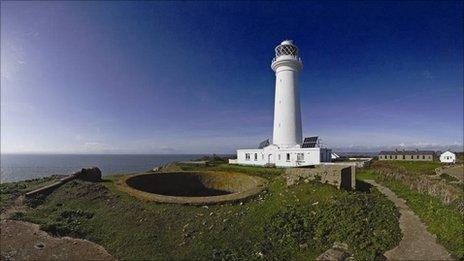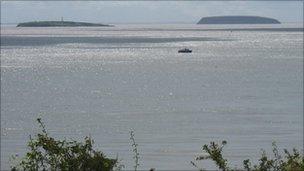Flat Holm for sale: Island rich in history and wildlife
- Published

Flat Holm island has a working lighthouse and a number of listed buildings
It has been a home to monks, Vikings, and Victorian and World War II soldiers, along with cholera sufferers and a few smugglers.
Gulls are also regulars, with the island an important breeding ground, while hundreds of visitors take a boat trip from Cardiff Bay to explore the wildlife haven every year.
But new inhabitants could soon be mooring on the island of Flat Holm after Cardiff council unveiled plans to sell it as part of wide-ranging cuts to save £110m.
Scrapping services like leisure centres and libraries has now, sadly, become a common way to save money for cash-strapped local authorities.
But selling an island - complete with a working lighthouse - is perhaps one of the more unusual ways to balance the books.
So who is most likely to be forking out for the small, wind-swept island - Wales' most southerly point - which is nestled in the Bristol Channel with neighbouring English-owned isle Steep Holm?
Land agent Chris Hyde, who sold the much smaller Sully Island off the Vale of Glamorgan coast about two years ago, said he expects interest from all over the world.
"With Sully Island we had interest from New Zealand, China - a lot of interest from China - Russia, South America, Europe, from all corners of the globe," he said.
"Owning an island for many wealthy people is exciting and ostentatious.

Marconi's pioneering radio work is honoured with a memorial on the island
"It eventually sold to a wealthy English businessman for well over the guide price of £90,000."
Mr Hyde, of agents Cooke and Arkwright, said he believes Flat Holm would be "an even better prospect for selling" as Sully Island was "merely 15 acres (6 ha) of heath land and there's nothing you can do with it".
"Flat Holm is bigger and has buildings - there's something you can do with it. You could derive an income from it," he said.
"I don't think it's the place for someone wanting to build a big hotel as it has protections.
"But it could be run in the same way it is now and a private buyer could run boats from the English side as well as the Welsh side."
Matthew Lipton, who has been living on Flat Holm as its warden for four years, said he hopes it would be sold to someone who would respect the "uniqueness" of the island.
"It's a cultural and historical site of importance, as well as for wildlife," he said.
"It has a wide and varied history and we've done a lot of work to restore many parts of it.
"I just hope it doesn't all go to rack and ruin, and I hope a wildlife organisation might buy it."
"Uniqueness" would certainly be a selling point for the island, which covers about 86 acres (35 ha).
Flat Holm was first inhabited in the Bronze Age - as shown by artefacts found on the island - but the first recorded occupier was St Cadoc in the 6th Century AD who used the island as a retreat for quiet meditation.
Vikings and Saxons, monks and silver miners have all occupied Flat Holm at some point, while brandy and tea smugglers used its rocky coves to store contraband.

Flat Holm - and its neighbour Steep Holm (right) - are visible from the south Wales mainland
In later years, Victorian soldiers were based there and a series of gun emplacements were built to fortify the island after Queen Victoria became concerned about the strength of the French Navy.
Four of the battery sites and a gun pit remain on the island.
In the 1880s, the Marquis of Bute - who then owned the island - leased some of his land to the Cardiff Corporation for a hospital to deal with an outbreak of cholera among sailors arriving in south Wales.
It is understood the last patient to be cremated on the island was at the end of the 19th Century.
Following these dark times came the pioneering work of Italian inventor Marconi, who famously used the island to send the first wireless message across the water in 1897.
A memorial to him can be seen on Flat Holm.
However, it wasn't long before the military returned to the island when World War II broke out.

Wild leeks can be seen growing on Flat Holm throughout the year
More than 300 soldiers were based there as it became a base for anti-aircraft defences and a radar station.
Nature is Flat Holm's main importance now - surrounding the historical remains are maritime grassland and rare plants such as rock sea-lavender and wild leek, which have led to the island being designated a Site of Special Scientific Interest and a Special Protection Area.
The island also has significant breeding colonies of lesser black-backed gull, herring gull and great black-backed gull.
Ross Clifford, the island's education officer who helps school children visit the island, said it was an important place as it taught children about history, nature, science and climate change.
"It's really important that the right person buys it - someone that has the right aims for the island and are not trying to make it into a commercial venture," he added.
Mr Lipton added: "It holds a special place in a lot of people's hearts."
- Published1 February 2013
- Published25 June 2011